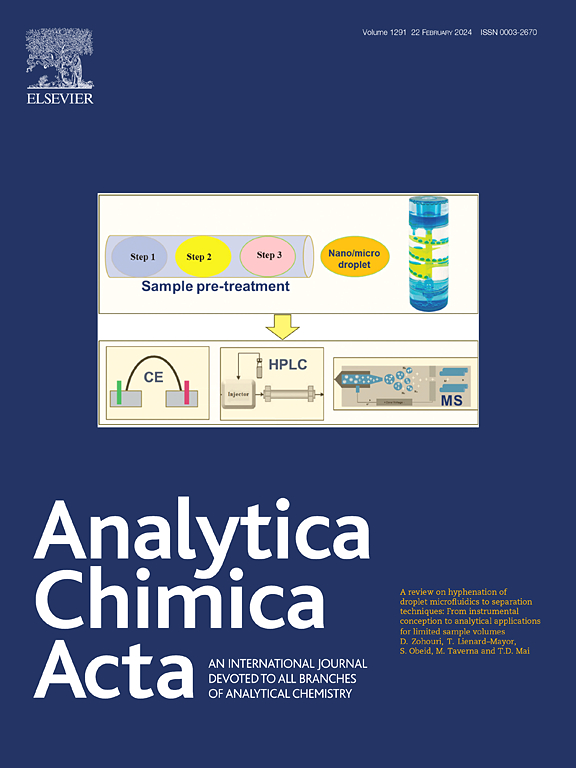重晶石伴生矿石稀土谱分析的双阶段基质消除- icp - ms方法
IF 5.7
2区 化学
Q1 CHEMISTRY, ANALYTICAL
引用次数: 0
摘要
重晶石相关地质样品中稀土元素(ree)的定量由于共存元素和重叠质谱干扰的持续基质效应而变得复杂。这些分析挑战在含有高浓度轻稀土(lree)的样品中尤其明显,在电感耦合等离子体质谱(ICP-MS)测量过程中,lree会导致重稀土(hree)的光谱重叠。结果两段式沉淀法对Ba、Na、Sr等9种基体元素的分离效率超过93.0%,717型阴离子树脂层析法对稀土元素进行了基团分离。甲醇-硝酸(3.40 mol/L, 7:3 v/v)和0.20 mol/L硝酸溶液依次洗脱,回收率明显不同:第一洗脱相hree (Eu-Lu)回收率为90.0%,第二洗脱相定量分离lree (La, Ce, Pr)。采用标准物质(GBW07892、GBW07893)对方法进行了验证,测定结果与认证值一致。并对三种天然重晶石伴生稀土矿进行了应用。该方法通过消除基体元素和控制LREE/HREE分馏,解决了稀土元素分析的关键限制。所有稀土元素的回收率为90.2-106.9%,证实了操作的稳健性,而在认证材料和现场样品中的成功应用为地球化学表征建立了可靠性。洗脱序列优化为重晶石伴生矿中稀土元素分析提供了模板。本文章由计算机程序翻译,如有差异,请以英文原文为准。

Dual-stage matrix elimination-ICP-MS methodology for REEs profiling in barite-associated ores
Background
The quantification of rare earth elements (REEs) in barite-associated geological samples is complicated by persistent matrix effects from coexisting elements and overlapping mass spectral interferences. These analytical challenges are particularly pronounced in samples containing high concentrations of light REEs (LREEs), which induce spectral overlaps on heavy REEs (HREEs) during inductively coupled plasma mass spectrometry (ICP-MS) measurements.
Results
A two-stage precipitation protocol achieved separation efficiencies exceeding 93.0 % for nine matrix elements (Ba, Na, Sr, etc.), while subsequent 717-type anionic resin chromatography enabled group separation of REEs. Sequential elution with methanol-nitric acid (3.40 mol/L, 7:3 v/v) and 0.20 mol/L nitric acid solutions yielded distinct recovery profiles: HREEs (Eu–Lu) showed >90.0 % recovery in the first elution phase, followed by quantitative isolation of LREEs (La, Ce, Pr) in the second phase. The method was verified by using certified reference materials (GBW07892, GBW07893), and the determination results were consistent with the certified values. The application to three natural barite-associated REE ores was also realized.
Significance
This methodology resolves critical limitations in REE analysis through matrix element elimination and controlled LREE/HREE fractionation. The demonstrated 90.2–106.9 % recovery range across all REEs confirms operational robustness, while successful implementation in certified materials and field samples establishes reliability for geochemical characterization. The elution sequence optimization provides a template for analyzing REEs in barite-associated ores.
求助全文
通过发布文献求助,成功后即可免费获取论文全文。
去求助
来源期刊

Analytica Chimica Acta
化学-分析化学
CiteScore
10.40
自引率
6.50%
发文量
1081
审稿时长
38 days
期刊介绍:
Analytica Chimica Acta has an open access mirror journal Analytica Chimica Acta: X, sharing the same aims and scope, editorial team, submission system and rigorous peer review.
Analytica Chimica Acta provides a forum for the rapid publication of original research, and critical, comprehensive reviews dealing with all aspects of fundamental and applied modern analytical chemistry. The journal welcomes the submission of research papers which report studies concerning the development of new and significant analytical methodologies. In determining the suitability of submitted articles for publication, particular scrutiny will be placed on the degree of novelty and impact of the research and the extent to which it adds to the existing body of knowledge in analytical chemistry.
 求助内容:
求助内容: 应助结果提醒方式:
应助结果提醒方式:


